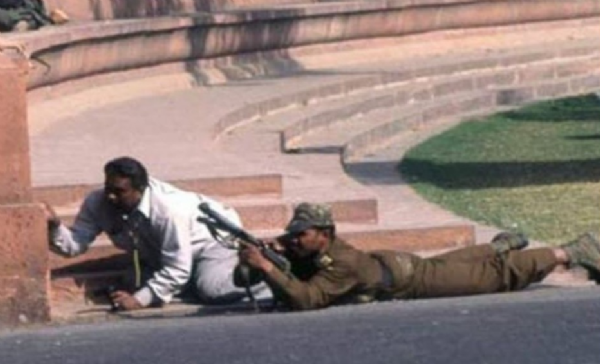2001 Parliament attack: When these HEROES defended our temple of democracy!
13 Dec 2023 10:32:20
2001 Parliament attack: In Indian history, we will remember the date December 13, 2001, as a black day. Five Pakistan-based terrorists claimed the lives of at least nine people including six security personnel, two Parliament Security Service personnel, and a gardener in an attack on the heart of democracy, the Indian Parliament.

22 years ago, no one would have even imagine a terrorist attack will take place within the Indian Parliament premises that had shocked the whole country. The then Home Minister Lal Krishna Advani, addressing the Lok Sabha, remarked, "It is now evident that the terrorist assault on the Parliament House was executed jointly by Pakistan-based and supported terrorist outfits, namely, Lashkar-e-Taiba and Jaish-e-Mohammad."
What had happened?
Around 11.30 am on that day, five heavily armed militants stormed in Parliament Complex, driving a white ambassador, used fake VIP cards and stickers to infiltrate. The intrusion took place around 40 minutes after the Parliament adjourned, with then Prime Minister Atal Bihari Vajpayee and Opposition Leader Sonia Gandhi having already left. Most of the 100 MPs, including Home Minister LK Advani, were inside the Parliament.
One of the members of the Parliament House Watch & Ward Staff, Jagdish Prasad Yadav,became suspicious about the identity of the car and immediately ran after it. The car was forced to turn backward and hit the then Vice President, Krishnan Kant's motorcade, initiating an unplanned confrontation.
After a fierce hour-long firefight between the terrorists and security personnel, all the terrorists were eventually killed but also claimed the lives of five Delhi police personnel, including a Parliament security guard and a gardener. Despite the chaos, all ministers and MPs were taken out unharmed, and the incident was broadcast live on television. One militant, laden with ammunition, detonated himself at the main entrance to the Parliament chambers.
The terrorists aimed to enter the building and indiscriminately target the crowd of MPs and ministers. Despite the relatively small death toll compared to events like the 26/11 Mumbai terror attack, this incident stood out for targeting the heart of Indian democracy.The breach exposed inadequate security at the complex, urging the government to invest significantly in enhancing security measures. Further investigations linked Afzal Guru, SAR Geelani, Shaukat Hussain and Navjot Sandhu to the case.
What after that attack?
The Delhi Police special cell cracked the case within 72 hours and it was revealed that the five terrorists forming the suicide squad were all Pakistani nationals, associated with the militant groups Lashkar-e-Taiba (LeT) and Jaish-e-Mohammed (JeM).
Mohammad Afzal Guru, a former JKLF terrorist, his cousin Shaukat Husain Guru, Shaukat’s wife Afsan Guru, and SAR Geelani, an Arabic lecturer at Delhi University, faced the legal consequences and were arrested. While Afsan was acquitted, Geelani was initially sentenced to death but later acquitted by the Supreme Court in 2005. Later, Afzal Guru was hanged to death in 2013. This was not it. The repercussions of the Parliament attack strained the already India-Pakistan relations.
India's diplomatic response included the recall of the Indian High Commissioner and a ban on civilian flights from Pakistan. The international community played a crucial role, with the then US President George W Bush engaging in talks with both nations to settle things between the neighbouring countries.A significant development emerged from Pakistan, where President Pervez Musharraf condemned the Parliament attacks as a terrorist act, drawing parallels with the 9/11 attacks on the United States. Under mounting pressure from the US and European nations, Musharraf took decisive steps, banning five Jihadi organisations, including Jaish-e-Muhammad and Lashkar-e-Taiba. He also acknowledged the need to regulate Madrasas.
Remembering the bravehearts
CRPF constable Kamlesh Kumari was posthumously awarded the Ashok Chakra by former President K R Narayanan for her courage and bravery against the Pak-based terrorists. Kamlesh Kumari was posted at Gate number 1, very close to Gate 11, which was the main entrance for the VVIPs coming to the Parliament. As soon as the vehicle entered, it began speeding, something that these cars don’t usually do.
She could have taken refuge, but as soon as she saw that the passengers in the car were heavily armed, she alerted other CRPF personnel and security guards on her walkie-talkie, running to Gate number 11 while doing so.
The four CRPF –Sukhwinder Singh, Y B Thapa, Santosh Kumar and Shyambir Singh–who shot the terrorists were rightfully awarded the Shaurya Chakra and promoted in their services. Post six months of his joining, Santosh Kumar started serving as a security personnel in the Indian Parliament. He shot down three out of five terrorists who attacked the heart of democracy.
December 13 has been inked in history as one of the most harrowing days the nation ever witnessed. The whole nation salutes and commemorates all the brave soldiers and workers who stood up long against the terrorist attack.